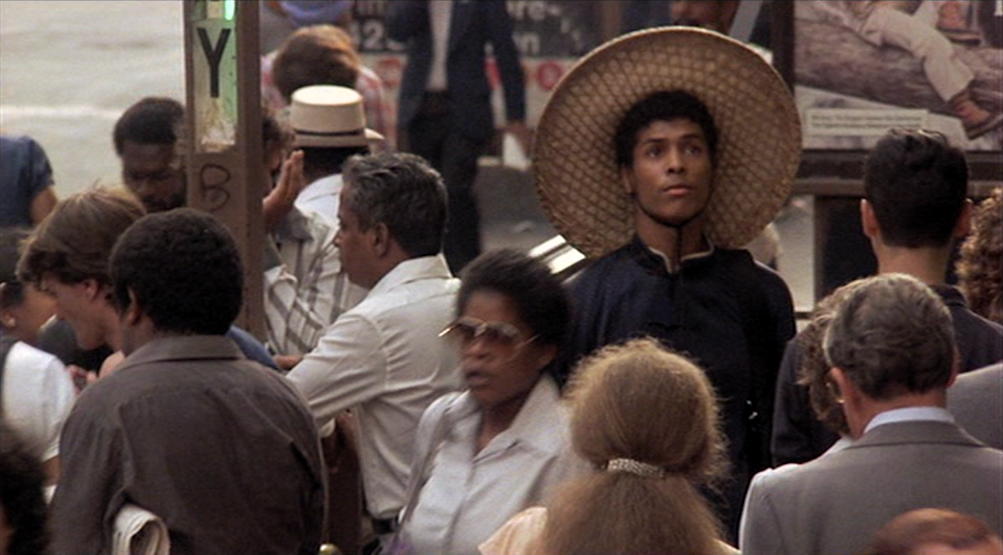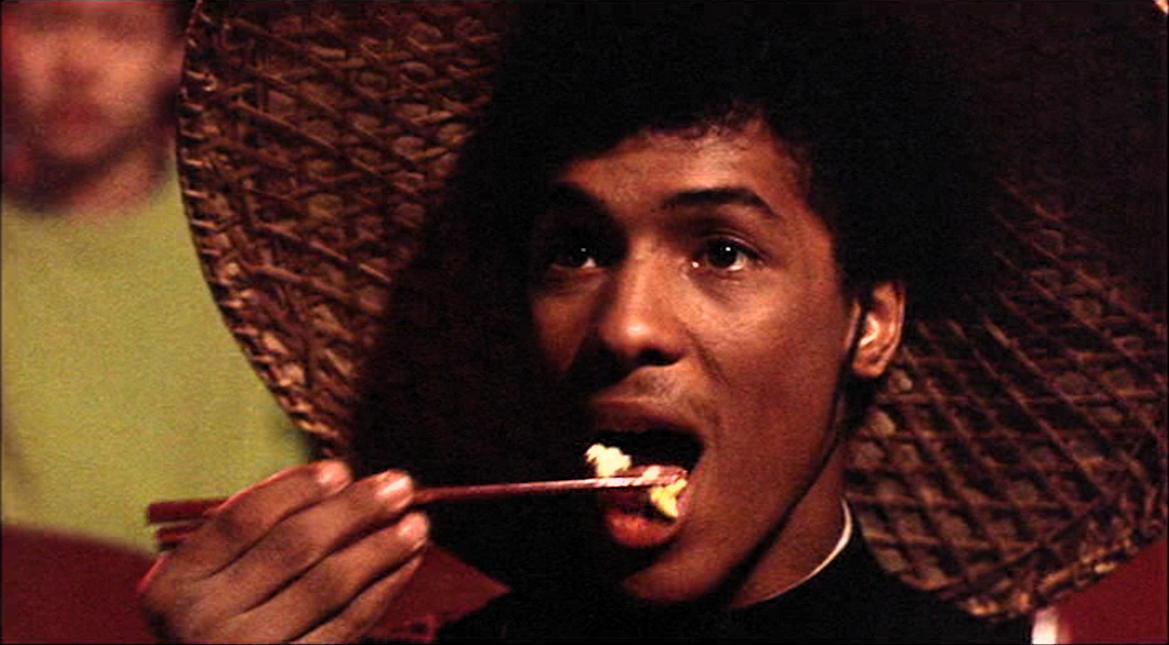Mimsy Review: The Last Dragon
“What you seek is not written on the floor.”
Special features
| Cast Information | 2 |
|---|---|
| Commentary Track | 5 |
| Trailers | 3 |
Damn, I loved this movie. My friends thought it had too much crappy Motown. I was willing to look beyond that to a very good movie. I even wrote up an AD&D martial arts character class based on the “level progression” shown by the characters in the movie, all the way up to “the glow”.
Yes, I know. TMI.
| Recommendation | Wonderful• |
|---|---|
| Director | Michael Schultz |
| Writer | Louis Venosta |
| Movie Rating | 7 |
| Transfer Quality | 7 |
| Overall Rating | 6 |
| Formats |
|

Leroy Green is out of place in both Harlem and the eighties.
Seeing martial artists fight over the petty fiefdoms of the slums was just brilliant. This is a deliberate cartoon reality, what director Michael Schultz called “a living comic book”. But despite that, it’s also somewhat real, in that the people within it recognize how out of place, and even silly, Leroy and the Shogun are.
There’s a lot of deliberate poking at stereotypes. An Asian using his ethnicity as a weapon against non-Asians; Asians acting blacker than black and running a fake-wisdom fortune cookie factory. An Asian martial arts master leaving town on a journey—to see his mother in Miami. And a couple of feuding black warriors running around Harlem dressed as Chinese and Japanese.1
Leroy Green, son of a black entrepreneur, dresses as a Chinese peasant and eats popcorn with chopsticks, and idolizes Bruce Lee. His younger brother calls him a “chocolate-covered yellow peril”. Sho-Nuff—we never find out what his real name is—dresses, as well as he can, as a samurai, and styles himself “the shogun of Harlem”. They’ve got a bit of a feud running: Sho-Nuff wants everyone to know he’s the master of martial arts in this town. But Leroy’s quiet confidence has got a lot of the kids thinking he’s at least as good as Sho-Nuff. But Leroy won’t fight: one of the tenets of his dojo is “May God help me if I ever have to use my art.”
Which can be taken two ways, but, at least for the first part of the movie, Leroy takes it as a prohibition on fighting.
The feud between the two martial artists blows up when a Jersey-born mobster, just as silly in his own way as the two warriors and with a penchant for picking up losers, gets involved. He wants dance club host and owner Laura Charles—played by Vanity—to highlight his artist’s music videos on her dance floor.
That rounds out the three main characters: Leroy, Sho-Nuff, and Laura. They all have one thing in common: they’re very good at what they do and they’re confident in their own abilities. Sho-Nuff knows he’s the best; his feud with Leroy is a tactical one: he needs to prove to the community that nobody can outfight him, so that he can command their obedience as the master of Harlem. That’s why he can’t just beat Leroy up. Leroy has to fight back or some people might still believe someone could be better than the Shogun.

Who are these people?
Leroy is supremely confident, and speaks like a fortune cookie—probably because his own teacher is hooked on them. Every success Leroy has he has because of his confidence; when he falters it is when he lets his confidence fail him. When he lets his instincts take over he is unstoppable.
And that’s how he gets Laura Charles to fall for him. He pulls an inadvertent Tao of Steve• on her. For her own part, she is a competent, successful businesswoman and local media star who has no idea what’s about to happen to her. When we first see her, William H. Macy in a bit part is trying to convince her that she has to meet with mobster Eddie Arcadian; Macy’s character says he’s been threatened. She tells him exactly what she should: “Why don’t you just call yourself a cop, okay? My life is not filled with all that craziness.” Her character is well-written, reacts smartly given the craziness she’s suddenly involved in, and is very well-acted by Vanity (Denise Matthews).
All of the actors are very good. Leroy and his brother (played by Leo O’Brien) have a great chemistry between them. Julius Carry has an amazing presence as the utterly silly Sho-Nuff. That’s a hard role to pull off. And this was the first role for Taimak (Leroy); according to Schultz, he had three acting coaches trading off to get him up to the part. They did a great job.

“The mysterious and elusive Leroy Green.”
Leroy is supremely confident except for one thing. This is a partial spoiler, so I’ve hidden it behind the mouse2. It’s a great quote that sums up the movie:
(Quote hidden.)
“A true master would use this to hold up his pants.”
Despite his mastery of himself to the point that he can knock arrows out of the air, catch arrows out of the air, and even know the color of arrows in flight, he still looks outside himself for proof of his skill. He takes the peaceful nature of his teachings too far, refusing to fight even when he should defend his friends.
Schultz called Leroy a Tom Mix for kids of the eighties. That’s about right. It’s also very D&D-like. Like the martial arts character class in early Dungeons and Dragons games, the levels are distinct—and high level martial artists fight the next level of martial artists to reach that level.
There’s an audio commentary by director Michael Schultz. There’s a lot of white space, especially toward the end. When he does talk, however, he’s got some interesting things to say, both about the overall movie and the technical aspects. Besides wanting to make a Tom Mix for the eighties—and for blacks—he also wanted to go back to a romantic movie, kind of a Cary Grant connection between Leroy and Laura. He wanted to make both an homage to and a parody of Kung Fu movies, Soul Train, music videos (especially Cyndi Lauper) and music video producers, and happy endings. I’m not sure he got the parody right, but as an homage, definitely. This is a happy movie, and in that sense it’s a bit of a throwback. There’s not a lot of the cynicism in it that we might otherwise expect from an eighties movie taking place in Harlem and riffing off of Bruce Lee.

One of these outfits is meant for an over-the-top dance number. The other is meant as normal street clothing.
On the more technical end, he says that the final budget came in at 10 million dollars; and in 1985 “that was a medium budget picture”. There were very few special effects. The most obvious was the rudimentary rotoscoping used toward the end. Surprisingly, and I’m not sure I believe it, even the opening scene of Leroy blocking arrows with his hands was not a special effect. According to Schultz they spent two hours getting the timing right on that scene. They shot the arrows at a predetermined location and then Taimak practiced until he could do the scene. That’s almost as freaky as the arrow scenes from The Seven Samurai.
Schultz says that there were no stuntmen at all per se: all of the stunts were by martial artists. Taimak was a martial artist first, and did his own “physical work”. Vanity did as well. Julius Carry did have some martial arts stand-ins, but mostly did his own work, despite not knowing martial arts.
Schultz only voiced a couple of disappointments with the movie. One was behind the scenes: a problem with filming the movie in New York City was that the New York unions were “ten years behind” the rest of the country in terms of opening up to minorities and women. In a film where the cast was mostly black, their crew of a hundred had only one black union member. The other disappointment was that Berry Gordy overruled him on the soundtrack. While he wanted to have the Motown soundtrack just as Berry Gordy did, he also wanted to interweave Chinese music, and Gordy overruled him on that.
Ultimately this is an eighties movie; the era shows in the music (DeBarge, Vanity, Charlene) and in the dress and hair of everyone except the two male leads. But between the eighties music is an impeccably-timed, well-directed and acted movie about the balance between peacefulness and self-defense. It’s a lot of fun, and very rewatchable.
“Sometimes it is hard to live the way of the wise.”
| Director | Michael Schultz |
|---|---|
| Writer | Louis Venosta |
| Actors | Denise Matthews, Taimak, Julius Carry |
| Length | 1 hour, 48 minutes |
| Spoken languages | English, French, Portuguese |
| Subtitles | Chinese, English, English (CC), French, Korean, Portuguese, Spanish, Thai |
| Special Features | Cast Information, Commentary Track, Trailers |
| More links |
- The Last Dragon• (DVD)
- This eighties martial arts movie has a lot of heart—and a lot of eighties Motown. But hidden behind the dated music is a very tightly-directed movie that’s worth seeing.
- The Seven Samurai
- Probably the most influential samurai film, starring Toshirô Mifune and directed by Akira Kurosawa. It inspired more than just samurai: “The Magnificent Seven” was “Seven Samurai” remade into one of the most influential westerns.
- The Tao of Steve•
- The Tao of Steve McQueen: Dex has mixed Buddhism and Taoism into the laws that make the prototypical cool American hero.

Jerry, good review of an 80's Classic. Kudos for being able to see through the on purpose 80's cheese to see a movie with true character. Check out the Tribute to The Last Dragon: http://sites.google.com/site/lastdragontribute
@TheLastGlow at 4:31 p.m. November 28th, 2011
bfr2j
SHO NUFF!!!
Hark Thrice at 12:35 p.m. March 29th, 2014
9H8mG
This is a great analysis of a very underrated film. I need to watch it again if only to hear "chocolate-covered yellow peril" again.
Hark Thrice at 5:21 a.m. April 29th, 2015
qNTTT